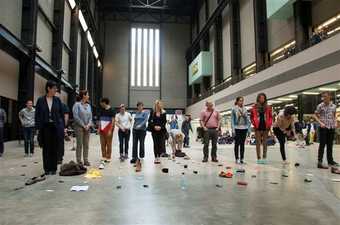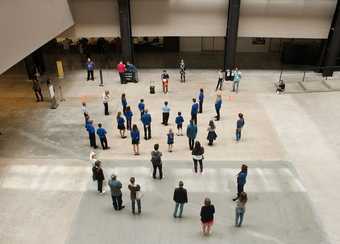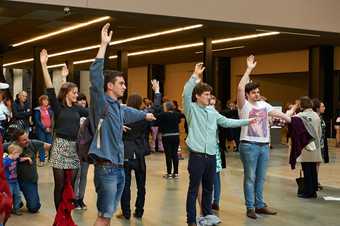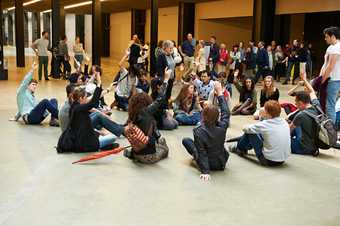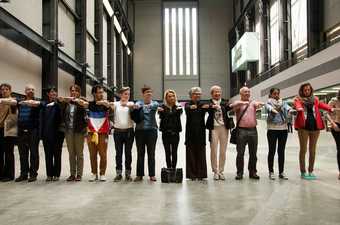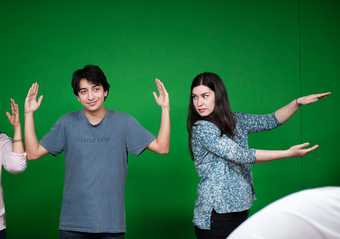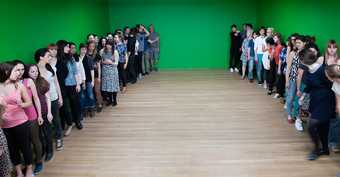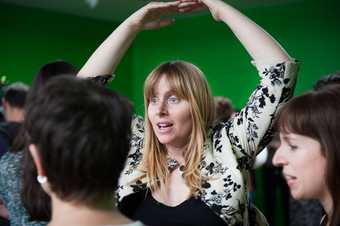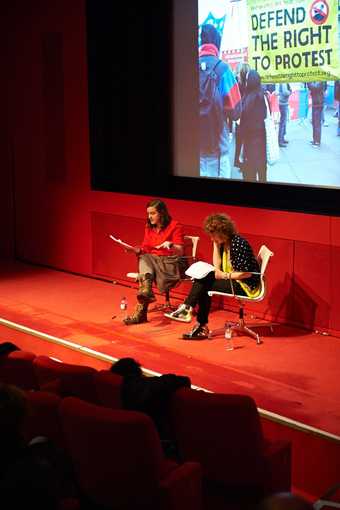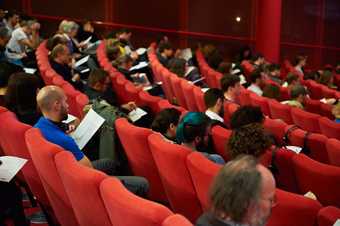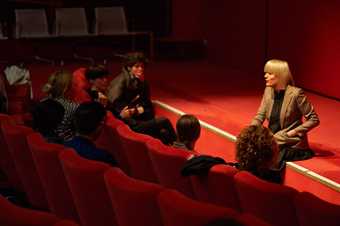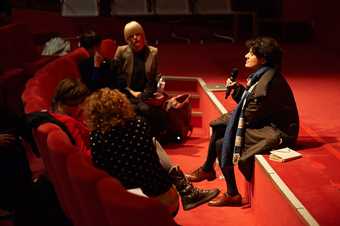Spatial Confessions (On the question of instituting the public) was a four-day programme that took place at Tate Modern between 21 and 24 May 2014 examining the question of ‘publicness’ within museum spaces, particularly those that exhibit contemporary art. Orchestrated by Bojana Cvejić, the event included live and online performances, talks and films, all of which explored how people perform in public and how they present themselves as both social citizens and private individuals. Although each component of the four-day event was designed to be in dialogue with others, they were divided into three main parts. Moving Part was a series of choreographic experiments staged within the public arena of Tate Modern’s Turbine Hall on 21, 23 and 24 May. On 22 May, a choreographed work called Spatial Confessions took place as a part of Tate’s ongoing digital Performance Room series and was broadcast to an online audience. The third part initiated a public symposium, Speaking Part, which ran throughout the afternoon of 24 May; it involved a series of talks, debates and film screenings. Although the work responded to the conclusions drawn from Public Sphere by Performance, a book Cvejić produced with Ana Vujanović, the programme was devised specifically for Tate Modern. Over the full course of the event, Cvejić collaborated with Christine De Smedt, Lennart Laberenz, Marta Popivoda and Ana Vujanović, alongside other invited guests.
Spatial Confessions (On the question of instituting the public) questioned the social, political and choreographic forms of publicness that arise through contemporary art practices. By addressing performance as a form of social choreography – how bodies and habits are organised in society – Cvejić and her collaborators explored how politics and social relations play out in human interaction and decision making.
Born in Belgrade, Cvejić now lives and works in Brussels. She practises critical theory through writing and teaching, as well as performing in theatre and dance contexts. She is also the co-founder, with Vujanović, of TkH (Walking Theory), an artistic-theoretical platform and editorial collective. Vujanović, also born in Belgrade, is the chief editor of TkH Journal for Performing Arts Theory. As a freelance cultural worker Vujanović is particularly interested in an interdisciplinary approach to performance studies, often drawing on gender studies, theatre studies, anthropology and aesthetics. The primary collaborator for Cvejić’s curated programme at Tate was De Smedt, who earned a degree in criminology before studying dance and performance. From 1991 until 2012 she was also a member of dance company Les ballets C de la B.
Spatial Confessions: Moving Part
Spatial Confessions: Moving Part took place over three days in the Turbine Hall at Tate Modern. Cvejić worked closely with De Smedt and the filmmaker Lennart Laberenz. The project created a choreographed social experiment that altered the flow of visitors in the Turbine Hall. Cvejić and De Smedt devised the experiment alongside other collaborators, making use of choreographic instructions and movement patterns as a way to redistribute the general public within the space. Anyone in the Turbine Hall could take part in the experiment.
Using a megaphone, a speaker posed questions to the public whose responses would divide them up in different ways within the space. The questions examined what it means to be a citizen. They ranged from political identifications: ‘Form a line according to the degree of capitalism and socialism you live in’, to personal aspirations: ‘If you would like to change your job, form a line from the ramp’, cultural opinions: ‘If you think art is overrated go to the left border, the others go to the right border’, quick judgements: ‘Point to the person you think is the richest in the room’, or appearance: ordering by eye or skin colour. Throughout the process, individuals would stand alone, in relation to each other, or in groups. This distribution of the public within the space allowed for postures and formations to spontaneously emerge. Cvejić believed it made ‘people aware of what they stand for, what they would like to perform … [it’s] a reflection of daily life, how we perform in certain positions. How they move, how they stand still.’1 By translating people’s answers into movements and gestures, the work literalised the concept of a social choreography. The title of the whole programme, Spatial Confessions, came from this process. By ordering themselves throughout the space, the audience’s opinions could be revealed, or confessed spatially. There was nothing insidious about the project. ‘I believe that there is nothing hidden or secretive that gets disclosed here, it is just a game.’2 Even if the performer is lying, they are still performing.
The public in Moving Part created a temporary form of sociality by working with one another and in response to the instructions. An interesting relationship was also developed between those participating in the work and those who watched the event while passing through. Tape was used to mark out a rectangular performance area in the centre of the hall, allowing viewing access to visitors on the bridge or on the platforms in the upper galleries. A stop-motion camera on the bridge also recorded the choreographic patterns made by people within the space from the same vantage point, although the faces of the participants were obscured in the footage. Cvejić was intrigued by how people operate in empty spaces where there is no explicit artwork to view. The Turbine Hall, defined as a ‘supersized venue of post-industrial architecture’ with its ‘constant refashioning … from being a container of monumental sculpture to resembling a public plaza, from acting as a performance stage to symbolising a shelter, raises the question of the potential of deregulated, purposeless openness’.3
Spatial Confessions
In collaboration with Christine De Smedt, Marta Popivoda and Ana Vujanović, Bojana Cvejić devised a performance to be staged as part of the BMW Tate Live: Performance Room series on 22 May. The Performance Room series was a programme at Tate Modern that commissioned a series of work exclusively for web broadcast. There was just one space, without a physical audience, and everything was filmed on one camera. The performances tended to be around twenty minutes long. After the performance finished, there was a question-and-answer session between Cvejić, De Smedt and Catherine Wood, Curator of Contemporary Art and Performance at Tate. During the conversation, members of the online audience were able to send in questions via social channels such as Facebook, Twitter and Google+. After the live stream, the footage was then uploaded onto Tate’s website and YouTube channel for future viewers.
Spatial Confessions, like Moving Part, also made use of a choreographic survey. The performance stemmed from De Smedt’s 2005 9x9 project. In 9x9 De Smedt explored how choreography could be related to mass movement. The piece had fifteen different iterations, in which different and particular groups of participants were given choreography and sets of instructions designed to address them exclusively.4 The participants in the Performance Room engaged in activities which responded to personal and political questions about private living space. Forty-seven volunteers took part and responded to forty-three questions. They were invited via a public call from Tate which was open to any gender and those between the ages of eighteen and ninety-nine; the only prerequisite was that the participants’ living space was smaller or equal to the size of the Performance Room (9.5 m x 5.5 m). This specification alluded to the high population density of London. The walls of the room were painted green to distance the space from the traditional white walls of a gallery environment. The participants responded to a series of simple questions and re-organised themselves as part of small or large groups in relation to one another. The movements developed were egalitarian and everyone was able to complete all the actions.
Just as the participants had in Moving Part, they answered a series of provocations through movement or gestures including jumping, raising their arms, stepping forwards and backwards, huddling in groups, making separate rings around such a group, or moving from one side of the room to the other. Brief moments of reflection and silence were quickly replaced by communal activity and discussion, particularly regarding questions which involved the group working together, for example in working out an accurate response to the instruction: ‘If the centre of the room is the UK, place yourself according to your country of origin.’ There was a limited time in which participants could respond, which paralleled the limited spaces in which they lived. Some of the questions were factual, such as, ‘If you work and live in the same space, take one step back’, or ‘If you spend more than 50 per cent of your income on rent, take one step forward’. Others were more political or opinion-based questions and these developed as the performance went on, including: ‘If you think that London is overcrowded, go to stand behind someone else’, or ‘If you think that more public money should be invested in social housing, place your arm upwards on the shoulder of the person closest to you’. The speculative nature of the questions accelerated as the questions became broader, provoking responses to a possible revolution, belief in governments, or the success of capitalism. The questions were not distributed in advance and, as such, all the reactions were spontaneous. Although there had been two rehearsals prior to the performance, this had been to explore group movement and to become familiar with one another. Unlike in Moving Part, it was obvious if people were affected by the rest of the group’s decision. Hesitation was palpable, as was the defiance of others to stand their ground. The lack of an audience in the space also highlighted the internal relations: ‘the group is the audience for themselves and each other. It is a performance that can perform itself for itself’.5
Unlike the public space of the Turbine Hall, the Performance Room offered a more intimate environment. By reflecting on this scaled down view of living conditions, it represented a domestic and private enclosed space. While Moving Part was inspired by how the ideology of the state appears in the presence of the crowd – with the perspective from the camera on the bridge recording anonymous mass movement and choreographic patterns of order – the Performance Room took a more personal approach, recording the individual participants from a roving camera and identifying them in the credits. When asked about honesty, Cvejić explained that the answer was less about truth, but more something the participants were ‘prepared to defend at that moment’. The public sphere, ‘if it even exists, is performed’.6 Spatial Confessions did not attempt to perform a legitimate sociological enquiry, although the survey allowed the participants to think about their individual situations within a collective environment. Broadcasting from the Performance Room over the web married the private and the public in unique ways, accessing an audience at home in their private spaces, perhaps encouraging them to reflect upon or to perform themselves at home. The archiving of the footage in the public realm of the internet also means that it could be watched and staged again by an unrelated group in the future.
Spatial Confessions: Speaking Part
The last part of the Spatial Confessions programme was Speaking Part, a one-day symposium titled ‘Is the public going to be instituted?’. Free and open to all, it ran from 14.00 to 19.30 on 24 May in the Starr Auditorium at Tate Modern. The conference addressed the question of ‘the public’ through a series of talks, debates, commentaries and film screenings. Speakers were selected to represent varying positions and perspectives, all considering if or how public institutions of contemporary art partake in a more political, discursive public sphere.
After an introduction from Cvejić, the art historian and theorist Claire Bishop and the philosopher Nina Power began the event in conversation. In her critical work, Bishop has argued in favour of museum practices that present visitors with ‘arguments and positions to read or contest’.7 During the conversation the two speakers discussed perspectives on how museum practice can institute notions of public order and public good. Ana Vujanović followed with her lecture ‘Public good will not be curated’, which expanded on the book Public Sphere by Performance which she co-wrote with Cvejić. Bishop, Power and Vujanović then answered questions from the audience. Following this, a short film composed from edited footage of past Turbine Hall projects was screened. Narrated by Claire Bishop and Catherine Wood, their running commentary considered how the public has interacted with works of art in the Turbine Hall throughout Tate’s history.
The audience was then encouraged to make their way to the Turbine Hall to witness Moving Part. Goran Sergej Pristaš delivered the next lecture, ‘Exploded Views’. A dramaturgist and associate professor at the Academy of Dramatic Arts, University of Zagreb, he is also the co-founder and member of the performing arts collective BADco. Straddling the themes of theatre, performance and the museum, his paper reflected on the ‘ex-position/posure’ of the public between the parallel apparatuses of theatre and the exhibition. The last film screening, Marta Popivoda’s Yugoslavia, how ideology moved our collective body 2013, explored how ideology can be physically embodied in public space. Using an experimental documentary format, Popivoda looked at footage of mass performances in Yugoslavia from 1945 to 2000, considering state performances, such as youth work actions, May Day parades, celebrations of the Youth Day, as well as counter-demonstrations, including May 1968, student and civic demonstrations in the 1990s and the 5 October revolution. The film traced how communist ideology was gradually exhausted through the changing relations between the people, ideology and the state. Popivoda, like Cvejić and Vujanović, is also a member of the TkH collective. As a filmmaker, video artist and a cultural worker, her oeuvre is concerned with the discursive power structures of the contemporary art world, as well as the specific iterations of culture and politics in the Yugoslav context.
Cvejić ended the symposium, and the programme, with her own final closing remarks to the audience. Cvejić commented that the event was ‘an opportunity to think out loud together in a setting less formal than a conference’, and a way to open out discussion and wider thinking about public space, performance and collective action.8
This was particular to the context of Tate Modern. In the symposium programme the artist published an ‘open letter’, which she had previously sent to all the speakers. The statement opened with a discussion of ex-Prime Minister Tony Blair’s farewell speech at the Turbine Hall in March 2007, one of many during his resignation period. Blair addressed Tate Modern as ‘the apogee of success in the decade of New Labour and mirroring the “art gains” of hugely increased visitor numbers thanks to the free admission policy, which, in Blair’s words, made “museums feel different”’.9
Cvejić perceived Blair’s speech as a key example of the way the bourgeois public sphere operates. Drawing on Tony Bennett’s study, The Birth of the Museum,10
she compared the contemporary art museum with the bourgeois public institutions of the nineteenth century. She argued that both are spaces of public assembly that civilise the crowd by way of polite and rational debate: ‘the liberal democratic public sphere exercises the capacity of individuals to internalise and perpetuate the techniques of self-monitoring the performative aspects of their conduct.’11
As an entire programme, Spatial Confessions explored how the public can perform an ideology in public space through actions, words and gestures. The Speaking Part conference raised questions about how far we can conceive of public space as an ample place for the public sphere to unfold.
Philomena Epps
October 2015

